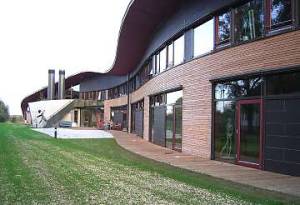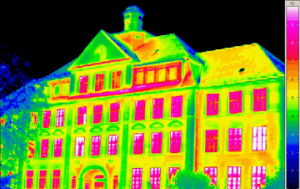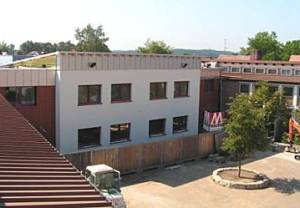This is an old revision of the document!
Table of Contents
Passive House schools – How to go about it
In the following, you will find recommendations on the basis of which the criteria 1 to 9 as stated in the article preliminary_contacts can be met with justifiable effort. These recommendations are not meant to be requirements – it is possible to deviate from them, but then compensating measures must generally be taken elsewhere. Calculations using the PHPP for checking whether criteria 1 to 9 have been met is decisive for achieving the Passive House standard [PHPP 2007] .
A favourable A/V-ratio
School buildings are often relatively large buildings. A/V ratios of less than 0.4 m²/m³ can usually be achieved if the buildings are well-planned, and not unnecessarily broken up – which increases costs. As a rule, the more compact the building is, the more cost-efficient it will be.
Excellent insulation
Thermal insulation should be of the Passive House Standard (U-values of the opaque building components of about 0.1 to 0.15 W/(m²K)). Depending on the building, one can apply improved roof insulation cost-efficiently and then for, example, use less insulation for the external walls. In general, the more compact the building is, the lesser the insulation thicknesses that will be required. U-values of 0.2 W/(m²K) should not be unnecessarily undercut for opaque building components as this would be less optimal economically. Individual U-values of very small opaque partial areas should not exceed 0.35 W/(m²K) (building physics at connections).
Absence of thermal bridges
Thermal bridge free implementation should be strived for as much as possible; this is generally easily achievable except at the base point of load bearing internal walls. If it is not possible to design details in a completely thermal-bridge-free manner, thermal bridges should be reduced as much as possible and the corresponding losses should be taken into account in the PHPP. The minimum internal surface temperatures should be above 13°C everywhere.
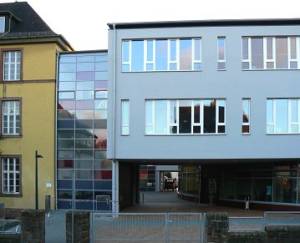
Airtightness
This is also essential for school buildings in the Passive House Standard. We even recommend that n50-values in the range of 0.3 h-1 should be aimed for. Numerous built examples show that for larger buildings, such values can be achieved relatively easy.
Passive House windows
The use of Passive House windows with Uw less than 0.8 W/(m²K) facilitates the achievement of the Passive House Standard, therefore they should only be omitted if temperature asymmetries can be excluded (e.g. by the use of heaters near the windows).
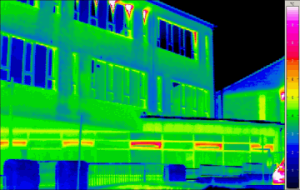
The temperature resolution and the colour scale are the same in both infrared images shown here. Source: Passive House Institute.
Ventilation systems
The installation of ventilation systems with sufficient fresh air flow rates is essential for good air quality in classrooms. The designed air quantities should be 15 to 20 m³ per person and hour during the period of use. Most importantly, the system must satisfy the criteria for hygiene. Note particularly the necessary filter qualities (at least F7 for external air) and to keep this filter dry (see also Air Quality in Schools; see Protocol Volume section by R. Pfluger and the Protocol Volumes [AkkP 17] , [AkkP 23] and [AkkP 30] ).
Highly-efficient heat recovery from exhaust air is essential for Passive House schools (heat recovery rate of about 80% and specific electricity demand for air transfer for designed conditions of 0.4 Wh/m³ of transferred air). The volumetric fresh air flow rate is high, otherwise it would lead to significant heat losses during the heating period. In Central European climatic conditions, it is not possible to realise a Passive House school using hygienically adequate window ventilation. It is also easier to maintain thermal comfort with heat recovery. The heat exchanger of the heat recovery must have a bypass (for summer operation).
The ventilation system must be equipped with a time control mechanism; regulation by means of presence detectors or CO2 sensors results in even better efficiency. The electricity consumption of the ventilation system will be too high without deactivation or extensive air flow rate reduction outside of the periods of use and purge phases.
Heating by means of the supply air
Heating the classrooms by means of the supply air can take place group-wise – e.g. for one facade side at a time. At the same time, it is possible to have centrally controlled heating up during the preliminary purge phase in the morning. For assessing extreme situations in a group of rooms there is a “risk assessment section” available in the “Heating Load” sheet in the [PHPP 2007] (see [AkkP 25] ). This system technology implies excellent overall thermal protection (no compromise with regard to the Passive House Standard).
Heating by means of supply air is not compulsory for Passive Houses; of course it is also possible to use heating panels and radiators. Various systems have been successfully used in Passive House schools as shown in the examples [AkkP 33] .
Thermal protection in summer
Particular attention must be paid to thermal protection in schools in the summer. In case of doubt, a thermal simulation for buildings is recommended. Generally, in schools there is a high proportion of glazing surfaces in the facade. Shading is usually necessary due to the high solar loads in summer (the only exception being for windows facing north). Temporary sun shades will usually be necessary. Adequate night-time ventilation (at least 2 h-1) during hot spells is equally important for school buildings. This is also possible by operating the ventilation system(s) in the bypass mode. Alternatively, building components can also be tempered.
High internal heat capacity
Due to the intermittent and periodically increased internal loads, a high internal heat capacity is recommended for school buildings. The capacities that can be achieved with solid interior building components (internal walls, ceilings, floors) are sufficient. If the available internal heat capacities are insufficient, this must be compensated for by other high-performance systems for summer cooling (night-time ventilation and shading alone will not be sufficient for this, because these components are required anyway and cannot work effectively in a purely lightweight construction).
Based on the useable area of the classroom, Ceff > 150 Wh/(m²K).
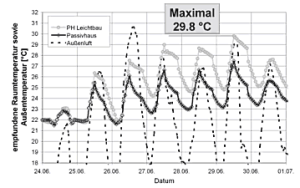
Conclusion
As shown by the examples of buildings which have already been built, applying these basic recommendations and the components available on the market today, it is possible to realise Passive House school buildings with various design concepts.
Passive House school buildings can be planned using the PHPP and that, except for some clearly defined features, the same focal points had to be taken into consideration for these as for residential or office buildings in the Passive House Standard.
An important boundary condition is the intermittent use with temporarily extremely high internal loads. The temporal average value of the internal loads with 2.8 W/m² on average is not much more than the values for residential use. Setback phases play an important role in school buildings. A tool is available for determining the expected effective temperature reduction [PHPP 2007] .
In school buildings particular attention should be paid to specific use in summer. Sufficient shading, night-time ventilation and high internal heat capacity are all imperatives. If it is not possible to meet one of these requirements, equivalent compensation must be provided – this can be concrete core temperature control or the use of adequate heat exchangers, for example.
For reheating after setback phases, the central heating generator must be able to provide a sufficiently high output (in the range of 50 W/m² of heated useable area). The pre-heating phase must be regulated via time control and internal temperature measurement.
Based on all previous experiences, the Passive House concept has proved to be just as successful for schools, where it is particularly advantageous due to the ventilation system’s importance.
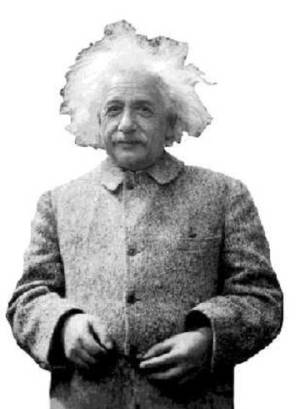
Literature
[AkkP 17] Dimensionierung von Lüftungsanlagen in Passivhäusern, Protokollband Nr. 17 des Arbeitskreises kostengünstige Passivhäuser Phase II; Passivhaus Institut; Darmstadt 1999.
(Dimensioning Ventilation Systems in Passive Houses, Protocol Volume No. 17 of the Research Group for Cost-efficient Passive Houses Phase II, Passive House Institute, Darmstadt 1999)
[AkkP 23] Einfluss der Lüftungsstrategie auf die Schadstoffkonzentration und -ausbreitung im Raum, Protokollband Nr. 23 des Arbeitskreises kostengünstige Passivhäuser Phase III, Passivhaus Institut, Darmstadt 2003.
(Influence of the ventilation strategy on pollutant concentration and distribution in rooms, Protocol Volume No. 23 of the Research Group for Cost-efficient Passive Houses Phase III, Passive House Institute, Darmstadt 2003)
[AkkP 25] Temperaturdifferenzierung in der Wohnung, Protokollband Nr. 25 Arbeitskreis kostengünstige Passivhäuser; Passivhaus Institut, 1. Auflage, Darmstadt 2004.
(Temperature differentiation in the home, Protocol Volume No. 25 of the Research Group for Cost-efficient Passive Houses, Passive House Institute,1st edition, Darmstadt 2004)
[AkkP 30] Lüftung bei Bestandssanierung: Lösungsvarianten, Protokollband Nr. 30 des Arbeitskreises kostengünstige Passivhäuser Phase III, Passivhaus Institut, Darmstadt 2004.
(Ventilation in refurbishment of existing buildings,Protocol Volume No. 30 of the Research Group for Cost-efficient Passive Houses Phase III, Passive House Institute, Darmstadt 2004)
[AkkP 33] Passivhaus-Schulen, Protokollband Nr. 33 des Arbeitskreises kostengünstige Passivhäuser Phase III, Passivhaus Institut, Darmstadt 2006.
(Passive House Schools, Protocol Volume No. 33 of the Research Group for Cost-efficient Passive Houses Phase III, Passive House Institute, Darmstadt 2006)
[Bretzke 2005] Bretzke, A.: Planung und Bau der Passivhaus Grundschule Kalbacher Höhe 15, Frankfurt am Main, 2005: PDF (in German).
(Planning and construction of the Passive House primary school in Kalbacher Höhe 15, Frankfurt am Main, 2005)
[Peper 2007] Søren Peper, Oliver Kah, Rainer Pfluger, Jürgen Schnieders: Passivhausschule Frankfurt Riedberg Messtechnische Untersuchung und Analyse, 1. Auflage, Passivhaus Institut, 2007. PDF (in German) to download it free.
(Passive House School in Frankfurt Riedberg – Metrological Survey and Analysis, 1st edition, Passive House Institute, Darmstadt 2007)
[PHPP 2007] Feist, W.; Pfluger, R.; Kaufmann, B.; Schnieders, J.; Kah, O.: Passivhaus Projektierungs Paket 2007, Passivhaus Institut Darmstadt, 2007.
(Passive House Planning Package 2007, Passive House Institute, Darmstadt 2007), see page PHPP – Passive House Planning Package
See also
Overview of built examples for Passive House schools on Passipedia
More built Passive House schools can be found on www.passivehouse-database.org
Overview of all articles on Passipedia about Passive House schools
Overview of all articles on Passipedia about non-residential Passive House buildings

